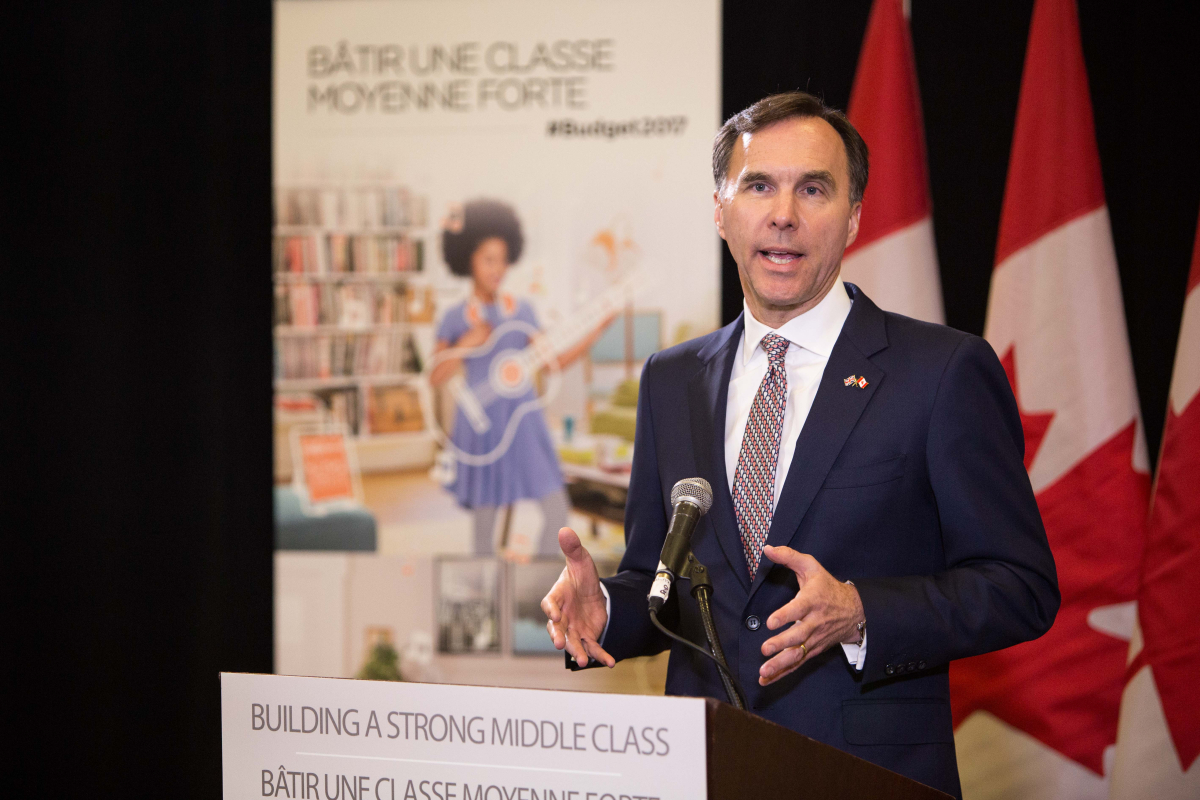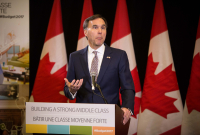Support strong Canadian climate journalism for 2025
There are doodles of wind turbines and photos of four smiling people on the cover page of Finance Minister Bill Morneau’s new federal budget.
The annual budget plan is arguably the most important policy document introduced by the government every year.
It is normally introduced in the spring at the start of the fiscal year and it sets the government’s priorities by defining where Ottawa plans to increase or maintain spending and indicating areas where cuts are on the horizon.
This year, the images selected on the cover of the main budget document reflect the Liberal government’s message about building a stronger middle class through policies and investments focused on infrastructure and clean energy.
The government says there is not a whole lot of new spending this year, but includes more detail on how it plans to spend billions of dollars that were already allocated in 2016. This includes some elements of the government’s plans to invest in infrastructure as well as to address climate change and support clean economic growth.
The budget also stays the course on a bunch of policies, despite having a new administration running Canada’s largest trading partner, the United States, which is reversing many of the policies introduced under former U.S. president Barack Obama.
But in some cases, spending promised in areas such as clean energy are being spread out or delayed beyond what was originally planned.

Here are some key highlights from the new budget.
- Multibillion dollar deficits: As expected, Canada will continue to rack up large deficits this year and over the next three years of about $25 billion per year. In other words, each year Canada’s spending will be $25 billion more than its revenues. That deficit is projected to decrease to $19 billion in 2019-2020, $17 billion in 2020-2021, and $15 billion in 2021-2022.
- Empowering women: The budget introduces a brand new federal policy to empower women in Canada’s society — a Gender Statement. This will require the government to assess how each of its policies could affect women as part of its objective to “advance the goals of fairness, stronger workforce participation, and gender equality,” Morneau said.
- Legalizing Cannabis: The government says it will use $9.6 million of its existing funds over the next five years to support education programs, as well as what it describes as “surveillance activities,” to keep marijuana out of the hands of children once it follows through on a commitment to legalize the drug.
- New powers to fight money laundering and terrorism financing: Canada’s financial intelligence agency — the Financial Transactions and Reports Analysis Centre, would get new powers under changes proposed in the budget plan. The government has not yet introduced legislation, but said it will soon do so to allow for more information to be shared about threats to Canada with the Department of National Defence and the Canadian Armed Forces. The budget also suggests that FINTRAC would get new powers to investigate and help law enforcement identify the people benefitting from shell bank accounts registered under someone else’s name.
- Teaching Canadian children a new “language”: Just as they learn to read and write one of Canada’s official languages in school, the government plans to spend $50 million to support teaching initiatives for children from kindergarten to Grade 12 so that they can learn computer programming and code coding skills — measures designed to ensure their success in an increasingly digital economy. Education is a provincial jurisdiction under Canada’s constitution and it was not immediately clear how this policy would be deployed in practice.
- Improving labour standards: The Morneau budget says the government is planning minor improvements to Canada’s labour code that would strengthen rules to crack down on employers that fail to pay wages owed, improve rights for more flexible work arrangements, and limit unpaid internships in the workplace.
- Undoing tax loopholes for the wealthy: The government admits in its budget that it has found that some wealthy Canadians are avoiding taxes by setting up corporations that lower their tax rates. It is proposing to review this and other loopholes to ensure a fairer tax system, but doesn’t set out a clear timeline for introducing legislation to deliver on this commitment.
- A tax on Uber: The government is proposing to amend Canada’s tax laws to level the playing field and ensure that ride-sharing businesses like Uber are subject to the same sales tax rules as taxis.
- Millions for asylum-seekers: The Morneau budget is proposing significant new investments of about $20 million per year to improve its support for asylum-seekers who come to Canada. In total, the government is projecting to spend about $94 million over five years on the country’s asylum system that has been struck in recent weeks by hundreds of people illegally crossing the U.S. border to seek protection in Canada.
- Chief Science Advisor: After what many federal scientists might have described as a decade of ‘muzzling’ under the former Harper administration, the Morneau budget is proposing to invest about $2 million per year to support the office of a chief science advisor — a Liberal campaign promise — to elevate the importance of science in the government and ensure that the public has access to federal scientific research.
- Axing the public transit tax credit: The Morneau budget has proposed to eliminate a popular but widely-criticized tax credit for monthly bus passes. Introduced by the former Conservative government, the credit allowed public transit users to get a small rebate on the cost of their bus passes. The measure was criticized for being an ineffective and expensive way to reduce greenhouse gas emissions. The government will save $1 billion over five years by eliminating the tax credit.








Comments
[This Repost was a Glitch, er' but worth leaving] @
http://www.cbc.ca/news/politics/budget-wednesday-advancer-1.4033985?cmp… earlier today;
This comment is awaiting moderation by the site administrators.
Flag
Gerald Landry
Justin, in 1957 the "Great Pipeline Debate" in the Legislature voted to fund Line 1 with Taxpayers money, led by C.D. Howe a Liberal from Thunder Bay. It was built by the Northern Ontario Crown Pipeline Corporation then leased to TCP, Trans Canada Pipelines who 60 years later has left 30% of Ontarian's without access to N/G. Eg. Jellicoe, host to a Compressor Station for 60 years has never been provided service.
Please remove their Charter, they are a greed driven failure. www.ontarioruralgrowth.ca
Now they are the proponent to supply Fracked Methane for the 20 + LNG Export Terminals on BC's Sunshine Coast. Earthquakes anyone, Fort St. John, Cushing Oklahoma, Dallas... I Motion they Frack gas along Sussex Drive. I think you have been experiencing some "shake em up baby" of the earth trembling kind, have you not?« less
38 minutes ago
Reply Share, Jerry O'Connor
Flag, Jerry O'Connor
Just once folks......just once.
I would like to see a Finance minister wear......NO SHOES....old or new....bought or leased.....borrowed or whatever.
That folks for me, would be a TRUE REPRESENTATION as to just how bad Canada's economy REALLY IS folks.
But truth is something that is all too often ignored with far too much regularity and far too much consistency when it comes to getting truth from any politician be him or her of the Liberal flavor of the month or....the Conservative flavor of the month.
[Now for the business at hand];
#8] Uber Tax, LoL, As counter thought, I have been proposing Heavy Haul Truckers pull off the "All Rights Reserved Card", along with “Right to Work”, and not bother with “Operating Authorities” refusing to pay for Commercial Weight Plates and tracking Inter-State Fuel Taxes - Mileage etc. It has been disgusting how Opportunist mayors and councillors have allowed Uber to destroy the livelihood of longstanding Taxi Business’s. I refer to this unchecked competition as “Part Time Pirates” often without any sense as to all the unseen Capital expenses real licensed business’s must adhere to. City Regulators should be ashamed of themselves for allowing this Uber Piracy to go on.
Shame now on our Federal Regulators who have not seen how exploitive Uber is. this opens the barn door for Uber Trucking and Air Service. Unregulated Free Trade at it’s worst, from the ground up.
#2] Empowering women: Troubling, likely more discrimination supporting Un-Equal Rights. I just read this last night:
These Men's Rights Activists Are Suing Women's Groups for Meeting Without Men; It’s an unexpected use of a decades-old civil rights law. Written by HANNAH LEVINTOVA JAN. 15, 2016 7:00 AM
http://www.motherjones.com/politics/2016/01/men-rights-unruh-act-women-…
It will be interesting to see if there is outright discrimination and bias. There is already lack of a Minister for the “Status of Men”. Something that peaks my interest with ongoing bias and abuse in the Family Court system, for me being 7 years now with some well fed lawyers nourished by the taxpayer funded, Ontario Legal Aid system.